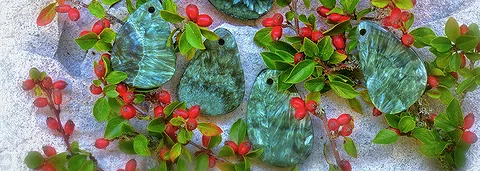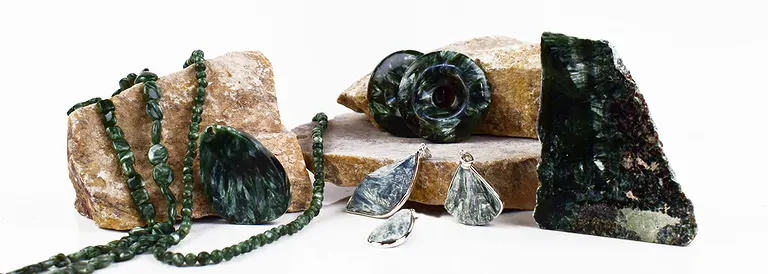
Stone of the Month August 2025: Seraphinite (Chlinochlor) - Meaning, Effect and Application
Berries, fruits and seeds ripen, the harvesting season slowly begins in nature. We can enjoy the warm days and consider ourselves lucky in view of the abundance around us. Gratefully we accept what nature has to offer during this time of the year and once again marvel at the wonder of life: colors, shapes and fragrances in all their diversity.
During this time, the green gem shows us at this time that we must remain careful and attentive despite all exuberance. Even if it bubbles around us with activity and joie de vivre, a critical introspection is also necessary. With the help of serafinite conflicts can be solved, we are open and ready for compromise and reconciliation. Old patterns are overcome or dissolved, calm and relaxed so we can look at what life brings us new.
Mineralogical profile Serafinite
Chemical formula: Mg,Fe5Al[(OH)8AlSi3O10]
Mineral class: phyllosilicate
Formation: by hydrothermal metamorphism in shale or Marble
Color: white, yellowish-green, olive-green, bluish-green, blackish-green
Gloss: vitreous luster, pearlescent luster, silk luster (fibrous)
Crystal system: monoclinic
Mohs hardness: 2 - 2.5
Cleavability: perfect
Localities, main supplier countries:USA (Pennsylvania), Russia (Ural), Tyrol (Schwarzenstein), Germany, (Upper Franconia). In commerce, donuts, Tumbled Stones, strands, etc. of Serafinite are mostly cut from Russian Serafinite. Its deposit is called Korshunovskoye and is located in the Irkutskaya Oblast region (Eastern Siberia); the mine is mainly used for open-pit mining of iron ore. It was there that the Russian mineralogist Nikolay Koksharov (1818 to 1893) discovered the clinochlor variety serafinite.
Appearance: Crystals foliated, pseudohexagonal, thick tabular, columnar and planar, often in fibrous formation with silvery-silky luster, often grown in radial rays
Use: Due to the radially grown fibrous formation and the silvery-silky luster, seraphinite is an attractive and popular gemstone
Availability: Rarity
Stringed beads, donuts, jewelry and more seraphinite at wholesale prices
Origin of the name Seraphinite and synonyms
Since the name clinochlor (the mineralogical designation) evokes associations with the toxic element chlorine, which, however, is not contained in the mineral at all, the trade name seraphinite was introduced. This meanwhile recognized designation applies only to the rare green-silvery clinochlor from Siberia.
The name clinochlor is derived from the Greek words "clino" and "chloros" and points to the inclined optical axis of the mineral and its typical green color. In the German language area the two variants Klinochlor and Clinochlor are to be found, in English the mineral is called Clinochlore, occasionally it is also called Clinochlorite. The name is composed of the Greek words klinein = incline (refers to the oblique inclination of the optical axis in serafinite) and chloros = green. Massive aggregates, from which e.g. Tumbled Stones can be produced, are mostly found in wholesale under the name Serafinite or Seraphinite. Another synonym is ripidolite.
Processing and use of Seraphinite
